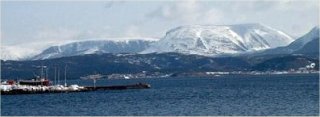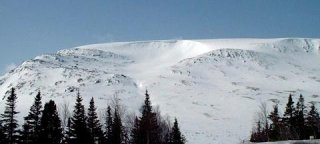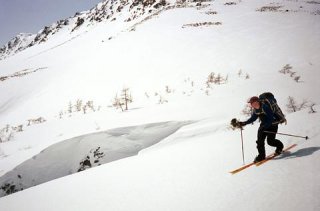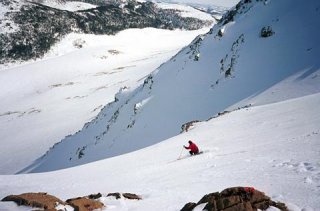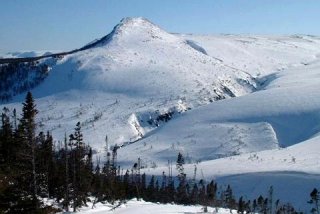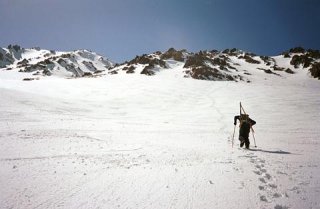Newfoundland, Canada (April 2001) – I drove seven hours
across the island of Newfoundland before picking up Bill, from Lake Elmore,
Vermont, at the Deer Lake airport and continuing an hour south, through Corner
Brook, to the Blow Me Down Mountains. I had never been to the Blow Me Downs,
and Bill had only been there once in the summer a few years ago.
n
|
|
The Blow Me Downs rise 2000 feet above a fjord and extend southward
for many miles. They are nearly devoid of vegetation due to the rock types
and the harsh weather. Their broad, flat mountain tops are flanked by steep
bowls and gullies. A highway passes between the fjord and the mountains and
there are numerous villages along the coast. It’s an easy two to three-kilometer
ski along the base of the mountains to the first skiable bowls and gullies.
This superb highway access, located an hour from a major airport, gives the
Blow Me Downs a reputation for having some of the best, most accessible backcountry
skiing in the East. It is the home of the only eastern snowcat skiing operation,
Blomidon Cat Skiing.
It had been a nice day, but the clouds were thickening and the
weather forecast was calling for a gale to begin soon. Our only two objectives
that evening were to scope out some skiable lines in the bowls and gullies
from the highway, and to find a tent site that was protected from the wind.
We could see that the mountainsides were steep and amply covered in snow.
So much snow that we would be able to ski directly from the parking lot that
lies nearly at sea level.
Finding a protected camping site was more troublesome. A gravel
pit near the parking lot had a great view, but it was completely open to the
southwesterlies blowing over the treeless ground. A rock quarry located a
couple kilometres down the highway was tucked into a 1,000 foot high cliff
that offered our tent, a four-season Mountain Equipment Co-op brand, some
protection.
The tent setup was complete just as the wet snow and rain began.
We tried cooking under a tarp attached to the car, but we quickly realized
that this was fruitless in the strong winds, and instead opted to cook in
the tent vestibule. Before crawling into our sleeping bags, we piled more
boulders on the guy lines of the tent – luckily, there was no shortage of
rocks in the quarry.
Sleep came in fits and starts. Just as I would nod off, another
gust of wind would rattle the tent and awaken me. At 2 a.m., the wind increased
and turned to northwesterly, which changed our formerly sheltered location
into one that was vulnerable to gusts coming off the fjord. These gusts lifted
the fly off the tent and buffeted us in our sleeping bags. As I was upwind
of Bill, I was constantly being pushed into him. The roar from the gusts could
be heard well before they hit us, and would hit with full force for about
10 seconds, then abate into 30-60 seconds of calm before the next gust. The
force of the impending gust could be predicted by the time that expired between
first hearing the distant roar and feeling it hit the tent. A minor gust had
a short roar, whereas a whopper had a long roar.
At 4 a.m., we were hit by a couple of huge blasts that dislodged
the piles of boulders holding down the guy lines. We scrambled out of the
tent between gusts to assess the damage and keep the tent in place, desperately
holding on so it wouldn’t blow away. When the next gust took all of our strength
to keep the tent down, I decided that we should take out the poles between
gusts and lie upon it until it could safely be transferred to the car. Luckily,
we got the poles out without snapping any of them, and then quickly rolled
up the tent and fly and stuffed them in the car.
The rest of the sleepless night was spent in a rocking car.
We estimated that peak gusts were 120 km/h (70 mph). The only things we lost
were a water bottle and a bowl. It could have been much worse, perhaps horrible,
if we hadn’t been camping next to a car. I’m glad to now be aware of the limitations
of my tent.
DETERMINED WEATHER
At daybreak, the snow stopped and the clouds started lifting,
so we searched for a sheltered spot where we could eat breakfast and change
into our ski clothes. The best place was on the dock in Frenchman’s Cove,
which was buzzing with activity because it was opening day of the lobster
season. To the lobstermen who were preparing to head out onto the choppy waters,
we must have been quite a spectacle with our plastic boots, skis, and poles;
one of them asked, “Are you boys going water skiing?”
Just as we reached the parking lot, the clouds lowered and the
snow began again. We started skinning along the base of the steep terrain,
hoping to reach a bowl spotted the previous evening that might offer protection
from the wind. At the 2 km point, the wet snow was soaking into our clothes
and the wind was persisting. After being knocked to the ground for the third
time, we decided to cut our losses by hiking up a short slope, making a couple
of token turns down it, and returning to the car. It was certainly awesome
to feel the force of Mother Nature, finding out why these mountains are called
the Blow Me Downs, but otherwise this trip had not started out well. We were
hopeful that our luck would change after picking up Paul, from North Bay,
Ontario at the Deer Lake airport that evening and spending the rest of our
trip to the north, in Gros Morne National Park.
CHALET-BOUND
|
|
Conditions improved dramatically overnight: the wind died, the
temperature dropped, and the sky cleared. We drove a half hour to Wiltondale,
on the edge of Gros Morne National Park, to pick up the key to a backcountry
chalet operated by Parks Canada. I’ve been skiing twice in Gros Morne, but
the others, who had not skied here, were pleased to see the deep snow covering
steep mountains as we drove into the Park and proceeded along the southern
shore of Bonne Bay to the Tablelands parking lot.
The Tablelands are composed of rocks similar to those in the
Blow Me Downs, and therefore are also treeless and with steep sides. It was
designated a UNESCO World Heritage Site in 1987 because its rocks display
a rare record of plate tectonic processes, and because of its spectacular
scenery, with alpine plateau, fjords, glacial valleys, sheer cliffs, and waterfalls.
We loaded our packs with three days’ worth of food and began
the 8 km trip into the Pic a Tenerife chalet. Other than a couple snowmobile
tracks, there were no signs of anybody else being up there recently. The route
to the chalet is generally slightly uphill as it skirts around the base of
the steepest slopes, climbing from 500 feet elevation at the parking lot to
1300 feet. We quickly ditched the skins upon discovering that skating or scrambling
was the quickest way to travel over the hard snow.
|
|
A preview of good things to come was found on the one downhill
slope along the route. On this south-facing pitch, the icy surface had softened
into corn that was highly turnable, even with our heavy packs.
At the base of a wide, moderately steep slope located 3 km from
the chalet, we could not wait any longer to taste the corn, so we dropped
our packs and started hiking. The snow conditions were awesome. Temperatures
were just a few degrees above freezing, allowing the icy surface to soften
ever so slightly. Ice sheets cut away easily under the ski edge, with each
turn shattering the sheets and sending pieces of ice down the slope in front
of us. The thousands of bits of glittering ice cascading down before me had
a mesmerizing effect that made it difficult to concentrate on turning on these
steep slopes. Wind-sifted powder that lay in pockets between the icy areas
remained dry while the corn softened underneath. It must have been the right
mixture of cool temps, dry air, and sunshine to allow for this powder/corn
combination, which I have only experienced once before in the Chic Choc Mountains
in 1995. What a delight!
After three runs on this slope, we moved southward to a wide
gully that I had scoped out in March. The gully has 1,200 feet of vertical
at a pitch that varies from 25 to 30 degrees at the bottom to 40 to 45 degrees
at the top. Unlike many of the other steep gullies on the Tablelands, this
one is not overhung by cornices. We had a superb run that started out steep
and narrow, then mellowed into a natural half-pipe that was fun to cut up,
finishing with a wide, smooth snowfield.
Unfortunately, the sun passed behind the ridge at 4:30 p.m.,
shadowing the slopes and returning them to their frozen state until due to
reawaken with the sun the next morning. Putting on the heavy packs and finshing
off the last three kilometers to the chalet was a real chore, especially because
it was uphill and against a stiff wind.
Once at the Pic a Tenerife chalet, however, life was good. The
3-year-old chalet has 900 square feet, a wood stove, stocked wood shed, 2
propane stoves with ovens, propane lights, a complete set of cutlery and pans,
indoor chemical toilet (actually a bad idea because of the smell), four comfortable
chairs, a sleeping loft for twelve, three pairs of slippers, and lots of windows
with superb views. We quickly had the place warm enough that jackets were
not necessary.
THE TRACKS FILL IN
Overnight, the wind changed from southerly to westerly, scouring
the little bit of loose snow out of northerly aspects and depositing it on
the easterly aspects that we had planned to ski this day. Actually, this additional
snow turned out to be very helpful because the temperatures remained cool
throughout the day, only allowing the lower couple hundred feet of the slopes
to soften into corn, with the upper slopes presenting a couple inches of wind-sifted
powder atop a firm, but edgeable base. Our first goal was to get on top of
the Tablelands near the chalet for a nice view, and we were rewarded with
stunning views and nice turns on the return trip.
We then headed back to the same slopes skied the previous day,
finding that our tracks and boot steps had been almost completely filled in
by the wind-sifted snow overnight. The rest of the day was spent arcing high
speed turns and soaking in the beautiful weather.
POWDER AND CORN
We were out of the chalet early with hopes of making some turns
near the parking lot, in Trout River bowl, before bringing Bill to the airport.
Overnight the wind died and early morning temperatures were much warmer than
the previous day. The corn was already soft on easterly aspects during our
trip out.
Trout River bowl was in superb shape, with soft corn on the
bottom gully and boot-top wind-sifted powder higher up. We made three runs
of 1,000 feet vertical each before having to head to the airport.
SUMMARY
It’s often difficult to get one sunny, not-too-windy day in
Newfoundland, let alone three in a row! We simply got lucky with the weather
and snow conditions, and took every advantage of them by skiing until exhaustion
each afternoon. The rare wind-sifted powder/corn snow combination was awesome
for turning.
The Blow Me Downs and Tablelands offer some of the best, easy
access backcountry skiing in the East. Highways pass right beneath the best
slopes and a major airport (Deer Lake, with daily direct flights from Halifax
and Toronto) is located less than an hour away. We skied three days on the
Tablelands and only touched a small portion of the terrain. There are numerous
runs with vertical descents of 1,000 to 1,200 feet at pitches of 30 to 40
degrees, but also lots of shallower runs with less vertical, especially near
the Pic a Tenerife chalet. There are numerous steep, 40- to 50-degree gullies
that have probably never been skied, yet could be done under the right conditions.
There are also nice-looking runs with 1,500 feet vertical on Gros Morne Mountain
and Killdevil Mountain. The chalet is a gem that only appears to be filled
a couple of weekends per winter when the local colleges use them in their
outdoor recreation courses.
One may ask why I am singing the praises of a place that is
virtually unknown to backcountry skiers outside of Newfoundland. It’s because
I’m not concerned about it being over-run by skiers, as I spent seven days
there this winter and didn’t see a single set of tracks that didn’t belong
to me or my friends. Plus, a higher usage of the chalet could encourage Parks
Canada to keep it properly maintained in future years.

